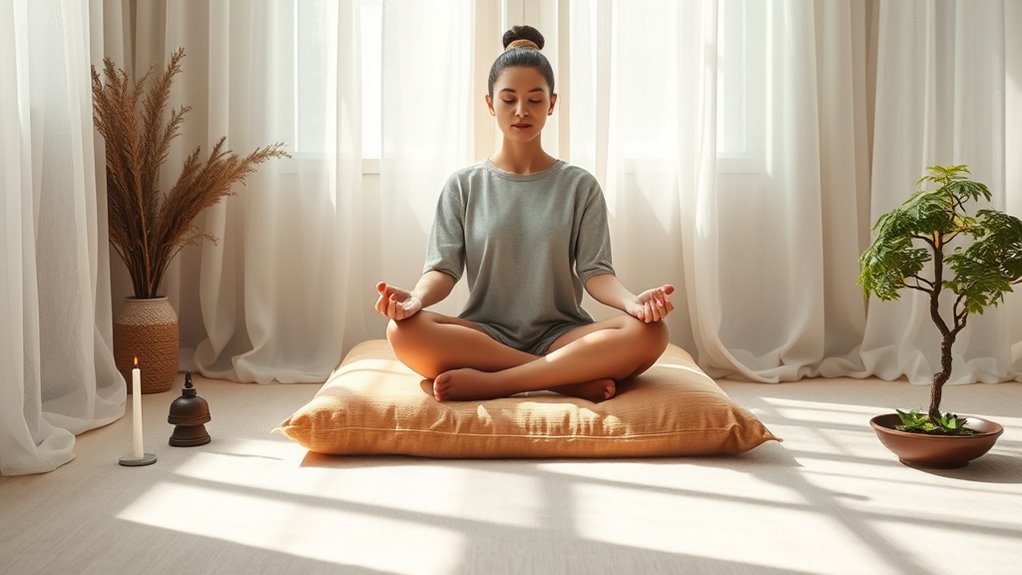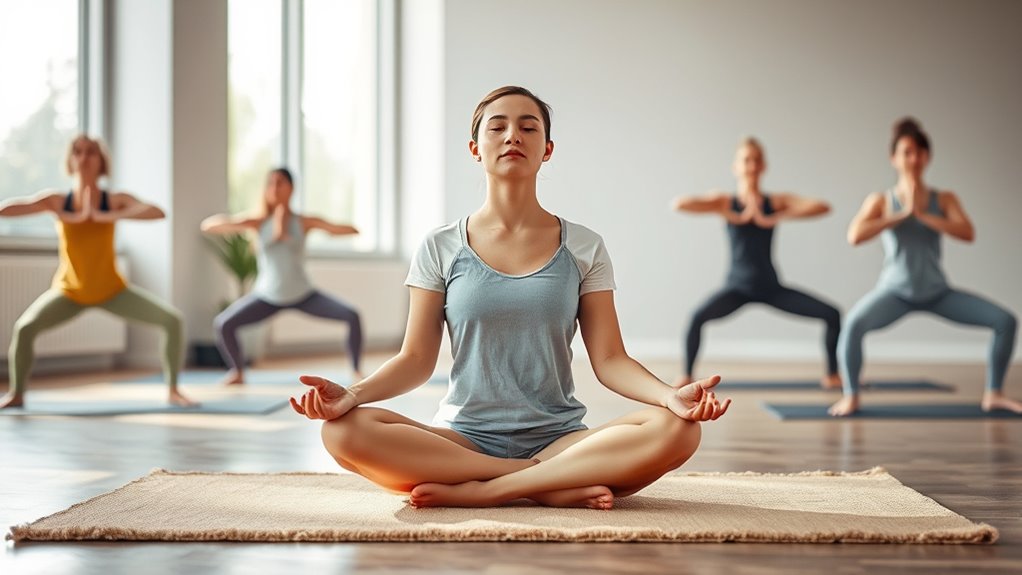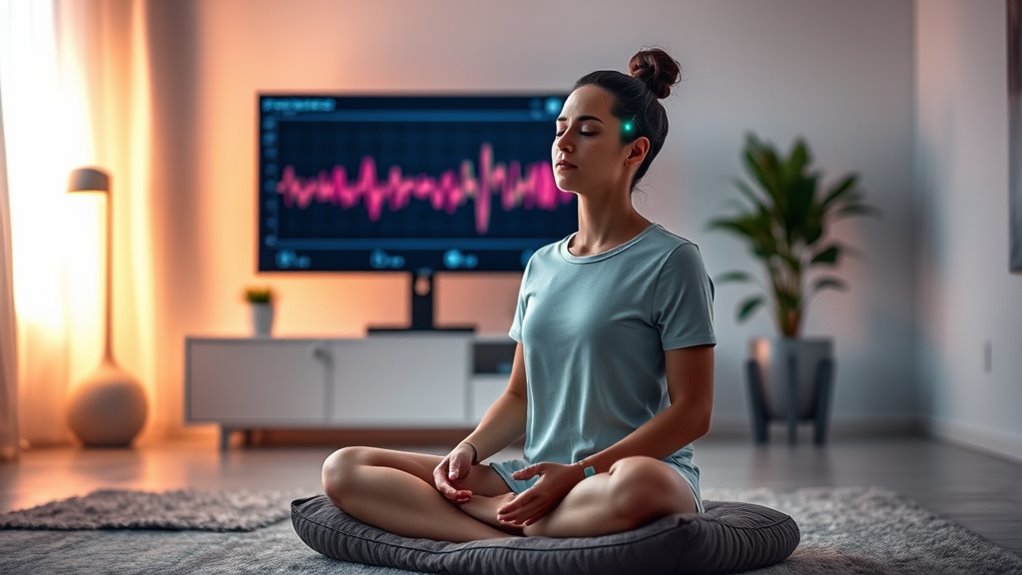Explore a variety of meditation methods to enhance your well-being. You can practice mindfulness and body awareness through techniques like body scans, mindful breathing, or movement-based practices such as yoga and Tai Chi. Incorporate visualizations, guided imagery, or compassion exercises to boost emotional resilience. Technology also offers tools like biofeedback, virtual reality, and brainwave entrainment to deepen your experience. Keep exploring to uncover more ways to tailor meditation to your needs.
Key Takeaways
- Meditation methods vary widely, including traditional practices like mantra meditation, visualization, movement-based techniques, and modern technological approaches.
- Cultural origins influence practices, such as Buddhist mindfulness, Sufi contemplative prayer, and Tibetan deity yoga.
- Techniques focus on mindfulness, body awareness, compassion, and emotional well-being through guided imagery and gratitude exercises.
- Movement-based practices like Tai Chi, Qigong, and yoga integrate physical movement to enhance mental clarity and physical health.
- Technology-enhanced methods such as biofeedback, virtual reality, and brainwave entrainment make meditation more accessible and personalized.
Overview of Mindfulness and Body-Based Techniques

Mindfulness and body-based meditation techniques focus on cultivating awareness through direct attention to sensory experiences and physical sensations. You fully engage with what you see, hear, feel, and taste, anchoring your mind in the present moment. This approach helps you notice subtle bodily sensations, such as the feeling of your breath moving in and out or the contact of your feet with the ground. By observing these sensations without judgment, you develop a heightened sense of awareness and acceptance. These techniques often involve simple practices like body scans or mindful breathing, which encourage you to tune into your body’s signals. As you deepen your awareness, you create a calm mental state, reduce stress, and enhance your overall emotional well-being.
Mantra-Centered Methods for Mental Calm

Mantra-centered meditation methods harness the power of repeated sounds or words to promote mental calm and focus. By silently or audibly repeating a chosen mantra, you create a mental anchor that reduces distractions and quiets restless thoughts. This practice helps you enter a deep state of relaxation and mental clarity. Different techniques use various mantras, from personalized phrases to traditional Sanskrit sounds. Here’s a quick look at key features:
| Technique | Focus |
|---|---|
| Transcendental | Uses specific, personal mantras for calm |
| Vedic | Sanskrit mantras for restful states |
| Acem | Softly repeated sounds for stillness |
| General Mantra | Repeating any chosen sound or word |
This approach cultivates inner peace and mental stability. Incorporating visualization and affirmations can further enhance the effectiveness of mantra meditation by aligning your thoughts with your goals.
Emotional Well-Being Through Compassion and Gratitude Practices

Practicing compassion and gratitude daily can transform how you experience your emotions and relationships. These practices help you cultivate empathy and foster a positive mindset. By intentionally focusing on kindness and appreciation, you strengthen your emotional resilience and overall well-being. Incorporating elements of mindfulness, such as emotional well-being, can further enhance these benefits and promote mental clarity.
Cultivating Empathy Daily
Ever wondered how small daily actions can boost your emotional well-being? Cultivating empathy daily starts with simple practices like practicing compassion and gratitude. Each day, take a moment to genuinely acknowledge others’ feelings and perspectives. You can do this by silently sending kind thoughts or offering sincere thanks to those around you. These acts strengthen your connection to others and foster understanding. As you focus on kindness, you’ll notice your ability to empathize deepening naturally. Incorporating essential oils for emotional well-being into your routine can also enhance your mood and promote relaxation, making it easier to connect compassionately with others. Consistently reflecting on what you’re grateful for also shifts your mindset toward appreciation, making it easier to relate with compassion. Incorporating these small, intentional actions into your routine helps build emotional resilience and nurtures a compassionate outlook that benefits your mental health and relationships.
Enhancing Positivity Mindset
Cultivating a positive mindset involves intentionally focusing on compassion and gratitude, which can considerably boost your emotional well-being. By practicing loving-kindness or gratitude meditation regularly, you shift your attention from negativity to appreciation. Start by visualizing someone you care about and send them well-wishes, or reflect on things you’re thankful for each day. This habit rewires your brain to notice positive aspects of life more easily. Over time, you’ll find yourself more resilient to stress and better able to handle challenges with a hopeful outlook. Incorporating these practices into your routine helps you develop a compassionate and grateful perspective, fostering emotional strength and a genuine sense of happiness. Small, consistent efforts can substantially enhance your overall positivity. Engaging in aquatic exercise can also support emotional well-being by providing a refreshing environment that promotes relaxation and stress relief.
Movement-Focused Meditations for Physical and Mental Balance

Movement-focused meditations are powerful practices that enhance both physical health and mental clarity by integrating body movements with mindful awareness. As you engage in these practices, you connect breath, motion, and attention, fostering a deep sense of presence. For example, Tai Chi and Qigong combine slow, deliberate movements with breath control, helping to improve balance, flexibility, and mental calmness. Walking meditation encourages you to pay close attention to each step, grounding your awareness in the present moment. Yoga Nidra guides you through body awareness while relaxing deeply. These practices promote harmony between body and mind, reducing stress and increasing vigor. Incorporating movement-based practices like these can also support overall wellness by improving circulation and energy flow. By moving intentionally, you develop resilience, clarity, and a balanced state that benefits your overall well-being.
The Role of Technology in Modern Meditation Practices

Technology has transformed how people access and practice meditation, making it more convenient and personalized than ever before. With apps, you can choose guided sessions tailored to your needs, track your progress, and set reminders to stay consistent. Virtual reality offers immersive environments that deepen your focus, while biofeedback devices help you monitor physiological responses like heart rate and breath, enhancing your awareness. Brainwave entrainment tools use sound frequencies to help you reach desired mental states faster. Online platforms provide instant access to a variety of techniques, from mindfulness to mantra meditation, allowing you to experiment and find what works best. Incorporating well-being solutions through technology bridges the gap between traditional practices and modern lifestyles, making meditation more accessible and adaptable to your daily routine.
Cultural and Historical Roots of Meditation Traditions

Understanding the cultural and historical roots of meditation helps you see how different traditions developed unique practices over time. These origins reflect the values, beliefs, and spiritual goals of various societies. Exploring their evolution reveals how meditation has shaped and been shaped by human history. Recognizing AI security concerns highlights the importance of safeguarding these ancient practices in the modern technological landscape.
Historical Origins of Meditation
Meditation has deep roots that stretch back thousands of years across various cultures and civilizations. You can trace its origins to ancient India, where practices like Dhyana emerged over 2,500 years ago, laying the foundation for Buddhist meditation. In China, Taoist traditions developed methods focused on harmony and inner balance, dating back over 2,000 years. The Indian Vedic traditions introduced mantras and rituals that influenced later meditation practices. In the Middle East, Sufi mystics practiced contemplative prayer and spiritual reflection, shaping Islamic meditation. Each tradition reflects unique cultural values and spiritual goals, yet all aim to foster awareness, insight, and connection. These early practices laid the groundwork for the diverse meditation methods you explore today, highlighting their enduring significance across different eras and societies. Additionally, the influence of ancient Hopi Village practices demonstrates how spiritual and cultural traditions remain vital to understanding human connection to land and identity.
Cultural Significance and Evolution
Throughout history, meditation has served as a vital spiritual and cultural practice that reflects the values, beliefs, and social structures of different societies. These traditions have evolved, shaping and being shaped by cultural identities. For example, Buddhist meditation emphasizes compassion and mindfulness, rooted in spiritual awakening. Tibetan practices incorporate visualization and deity yoga, symbolizing divine connection. Sufi meditation focuses on contemplation and spiritual reflection, fostering inner peace. Over time, these techniques have spread globally, adapting to new contexts while preserving core principles. Their cultural significance continues to inspire personal growth and collective harmony. Additionally, understanding the components of cultural intelligence can enhance cross-cultural appreciation and respect in diverse meditation practices.
Combining Meditation With Physical Postures and Movement

Combining meditation with physical postures and movement creates a dynamic practice that enhances both mental focus and body awareness. When you integrate movements like yoga, walking, or tai chi into your meditation, you engage your body actively while cultivating mindfulness. This approach helps you stay present in each moment, deepening your sense of connection between mind and body. It also improves flexibility, balance, and overall physical health. Moving meditation encourages you to observe sensations, breath, and physical alignment intentionally, reducing stress and tension. You become more attuned to your body’s signals, making it easier to release mental distractions. Incorporating mindfulness in motion into your routine can further amplify the benefits of your practice. This combination creates a holistic experience that nurtures mental clarity, emotional stability, and physical vitality simultaneously.
Using Guided and Visualizations to Deepen Practice

Guided visualizations serve as powerful tools to deepen your meditation practice by providing clear mental imagery and focused direction. When you follow a guided visualization, you’re led through a scene or scenario that engages your imagination, helping you relax more fully and stay present. This technique can evoke feelings of peace, safety, or compassion, depending on the theme. By concentrating on the imagery, you reduce mental distractions and enhance your awareness. Visualizations also help access deeper layers of your subconscious, revealing insights or emotional patterns. Using recordings or scripts, you can tailor visualizations to suit your goals, whether calming your mind, cultivating positive emotions, or exploring inner landscapes. This active engagement makes meditation more immersive and effective.
Biofeedback and Neurofeedback in Enhancing Meditation

Biofeedback and neurofeedback are innovative tools that help you optimize your meditation practice by providing real-time data on your physiological and brain activity. With biofeedback, you can see how your heart rate, skin conductance, or muscle tension respond during meditation, allowing you to adjust your focus for better relaxation. Neurofeedback tracks your brainwave patterns, helping you identify when your mind is wandering or in a desired state like alpha or theta waves. Using this feedback, you can train yourself to achieve deeper calmness and mental clarity more efficiently. These technologies turn abstract mental states into measurable data, making your efforts more precise. Over time, this targeted approach enhances your ability to enter and sustain meditative states, improving overall effectiveness.
Immersive Experiences: Virtual Reality and Brainwave Entrainment

Advancements in technology are opening new frontiers for enhancing meditation experiences through immersive environments like virtual reality and brainwave entrainment. Virtual reality transports you into calming, simulated worlds, allowing you to escape distractions and deepen your focus. You can explore tranquil landscapes, meditate on serene beaches, or sit within sacred temples—all from your own space. Brainwave entrainment uses sound frequencies to synchronize your brainwaves, guiding you into states of relaxation, focus, or deep meditation more quickly. Together, these technologies personalize your practice, making it easier to attain desired mental states. They also provide real-time feedback, helping you refine techniques and stay engaged. As these tools evolve, they offer compelling new ways to deepen your meditation and enhance emotional well-being.
Frequently Asked Questions
How Do I Choose the Best Meditation Method for My Needs?
To choose the best meditation method for your needs, consider your goals and preferences. If you want to improve focus, try focused attention or mindfulness meditation. For emotional healing, loving-kindness or gratitude practices work well. If movement helps you relax, explore yoga or walking meditation. Experiment with different techniques, notice what feels most natural and effective, and adapt your practice to fit your lifestyle and emotional needs.
Can Meditation Techniques Be Combined for Enhanced Benefits?
Yes, you can combine meditation techniques for better results, like blending mindfulness with loving-kindness to deepen emotional awareness. Picture a river merging two streams into a stronger current—each method adds strength and depth. You might practice body scan before mantra meditation, creating a calming flow. Experiment with combinations that suit your needs, and you’ll discover personalized routines that amplify your relaxation, focus, and emotional resilience.
What Are Common Challenges When Starting a Meditation Practice?
When starting a meditation practice, you might struggle to stay focused or find your mind wandering frequently. It’s common to feel impatient or frustrated when progress seems slow. You may also find it difficult to carve out time regularly or get comfortable sitting still. Remember, these challenges are normal. With patience and consistency, you’ll gradually improve your ability to focus and enjoy the benefits meditation offers.
How Long Does It Take to See Results From Meditation?
Patience is a virtue, and with meditation, you’ll see results at different times. Some notice benefits within days, like improved focus or calm, while others may take weeks or months for deeper changes, such as emotional resilience or spiritual growth. Consistency is key—regular practice helps your mind adapt and deepen its tranquility. Keep at it, and over time, you’ll start noticing positive shifts in your mental and emotional well-being.
Are There Any Risks or Contraindications Associated With Specific Meditation Practices?
Yes, some meditation practices can have risks or contraindications. If you have mental health issues like severe depression or anxiety, certain techniques might trigger uncomfortable emotions or thoughts. If you experience dizziness, headaches, or emotional distress, stop and consult a healthcare professional. Pregnant women or those with specific health conditions should seek guidance from a qualified instructor. Always listen to your body and adapt practices to suit your needs.
Conclusion
As you explore these meditation practices, think of yourself as a traveler charting a course through a peaceful forest, where each path offers a new way to find calm amidst life’s chaos. With openness and curiosity, you’ll uncover techniques that resonate, guiding you toward inner harmony. Remember, like a gentle stream carving its way through stone, consistent practice shapes your mind into a sanctuary of serenity and strength.








